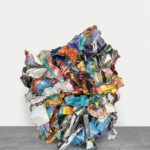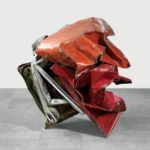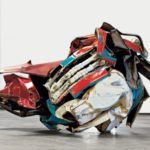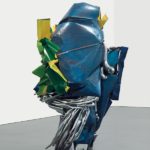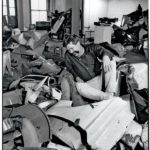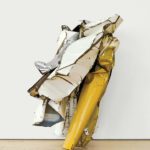Subscribe to Our Newsletter
A Good Fit
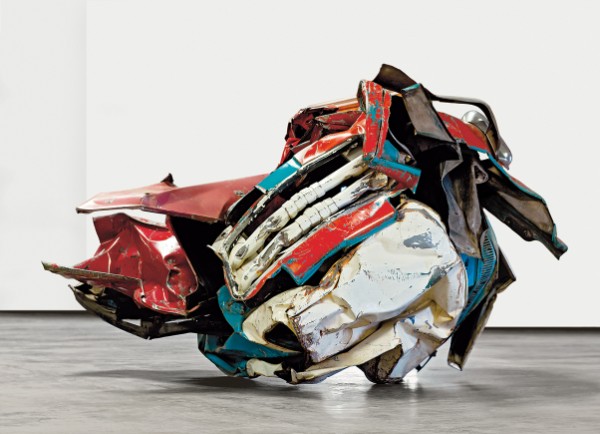
John Chamberlain found his own art materials where no one else was even looking and assembled them as a poet assembles words.
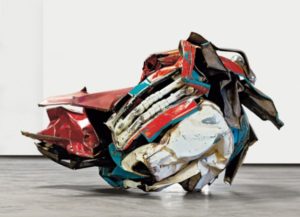
John Chamberlain, Papalote Goliad, 1974–75, painted and chromium-plated steel, 170.2 x 232.4 x 325 cm. THE CHINATI FOUNDATION, MARFA © 2018 FAIRWEATHER & FAIRWEATHER LTD/ARTISTS RIGHTS SOCIETY (ARS)
- John Chamberlain, Divine Ricochet, 1991, painted and chromium-plated steel and stainless steel, 138.4 x 180.5 x 169 cm. P R I VAT E C O L L E C T I O N , D U S S E L D O R F, C O U R T E S Y G A L E R I E K A R S T E N G R E V E , S T. M O R I T Z / PA R I S /C O LO G N E © 2 0 1 8 FA I R W E AT H E R & FAIRWEATHER LTD/ARTISTS RIGHTS SOCIETY (ARS), NEW YORK.
- John Chamberlain, Hillbilly Galoot, 1960, painted and chromium-plated steel, 147.3 x 165.1 x 147.3 cm. GLENSTONE © 2018 FAIRWEATHER & FAIRWEATHER LTD/ARTISTS RIGHTS SOCIETY (ARS)
- John Chamberlain, Papalote Goliad, 1974–75, painted and chromium-plated steel, 170.2 x 232.4 x 325 cm. THE CHINATI FOUNDATION, MARFA © 2018 FAIRWEATHER & FAIRWEATHER LTD/ARTISTS RIGHTS SOCIETY (ARS)
- John Chamberlain, PEAUDESOIEMUSIC, 2011, painted and chrome-plated steel, 341 x 223.8 203.2 cm. © 2018 FAIRWEATHER & FAIRWEATHER L T D / A R T I S T S R I G H T S S O C I E T Y ( A R S ) , ©2018 GAGOSIAN, PHOTOGRAPHER: ROB MCKEEVER
- John Chamberlain in his studio, 1964, Greene Street, New York. © 2018 FAIRWEATHER & FAIRWEATHER LTD/ARTISTS RIGHTS SOCIETY (ARS), NEW YORK
- John Chamberlain, The Hot Lady from Bristol, 1979, painted and chromium-plated steel, 210.8 x 129.5 x 127 cm. DIA ART FOUNDATION © 2018 FAIRWEATHER & FAIRWEATHER LTD/ARTISTS RIGHTS SOCIETY (ARS)
On January 5, 1960, just as the Sixties dawned, John Chamberlain had his first solo show. The 10 sculptures on view at the Martha Jackson Gallery in New York were all made from a startlingly new material, or at least, a material new to art—crushed and twisted fragments of automobile bodies, still with their original industrial paint and chrome trim. Salvaged from junkyards, the pieces were intricately fit together to make up complex abstract forms. Each sculpture was multicolored, the various paints either clashing or complementing each other, or both. Some suggest exotic flowers blooming or the intricate folds of drapery; some spread outward while others reach upward, lightly balanced on a tiny base.
Critics didn’t quite know what to make of these astonishing objects. Were they three-dimensional versions of de Kooning’s canvases? Were they some kind of commentary on America’s disposable car culture? Budding minimalist and part-time art writer Donald Judd saw deeper, noting especially the use of color in Chamberlain’s works, diametrically opposed to the monochrome tradition of both pre-modern and modernist Western sculpture: “The paint is folded into the convolutions of the metal and is unquestionably integral to the work,” Judd wrote in Arts Magazine. “Colored sculpture has been discussed and hesitantly attempted for some time, but not with such implications.”
The implications would unfold over time, as Chamberlain went through various phases of experimentation with materials and techniques. But the essence of his art was in place from the beginning and can be understood under two aspects—collage and material innovation. Chamberlain joined the modernist project of creation by combination, following Braque, Picasso, Schwitters, and many others, but he was quite indifferent to established ideas about which materials were appropriate for art and almost as indifferent to modernist rules about formalism and purity. “I’m basically a collagist. I put one thing together with another thing,” he told an interviewer in his typically blunt way. “I sort of invented my own art supplies. I saw all this material just lying around against buildings and it was in color, so I felt I was ahead on two counts there.” Chamberlain used automotive steel as raw material purely for its plastic and chromatic qualities, without any intention of alluding to the romance or danger of the automobile. Chamberlain considered himself an Abstract Expressionist, and indeed the sculptures are completely abstract. Their component parts are like-wise abstracted, their previous history stripped away.
Chamberlain was born in Rochester, Ind., in 1927, the son of a tavern keeper. His passion for industrial metal showed early; as a boy he was fascinated by aviation, building model airplanes and learning to fly his father’s 1931 Curtiss-Wright plane. After his parents divorced, Chamberlain moved with his mother and brother to Chicago, where he had his first experience of art, seeing Van Goghs at the Art Institute. After dropping out of ninth grade, he hit the road for California in hopes of getting into the movie business. He didn’t make it all the way there and instead ended up in Phoenix, Ariz., where World War II caught up with him. In September 1943 he enlisted in the Navy, at least partly to avoid vagrancy, and served aboard an aircraft carrier in the Pacific and in the Mediterranean.
Returning to Chicago after the war, Chamberlain felt the need to start a career and decided on hairdressing and makeup artistry, which he studied with financing from the G.I. Bill. It seems like an odd choice for the famously macho wild-man artist, but while he may have been motivated—as some have suggested—by the belief that it would help him pick up girls, one can also see a certain commonality between shaping hair and shaping sculpture.
By 1949, Chamberlain was taking classes from an artist named Lucretia Malcher, who lived near the salon where he worked, and around that time he made his first sculpture, a cat carved from a bar of Ivory soap—even then, he was finding his own materials.
In 1950, he enrolled at the School of the Art Institute of Chicago, where, he later said, he got more out of the art on view in the galleries than from the instruction in the classrooms and studios. A friend and recent graduate of the school, Joseph Goto, stimulated his interest in welded metal sculpture.
In 1952, Chamberlain left the Art Institute after an argument with a professor who gave him a low grade on a paper in which Chamberlain compared certain Indian architectural columns to nude human bodies, with an emphasis on how the bodies seemed to fit together. This incident is very telling about Chamberlain, not only in reference to his anti-authoritarian personality and sometimes difficult nature, but because the notion of the “fit” became the key to his whole artistic method. The metal elements of the sculptures he would make less than 10 years later were not crushed together; they were crushed before being assembled and then carefully, lovingly put together with an intricacy that is Chamberlain’s signature. “It’s all in the fit,” he would say again and again over the years. And for him, the analogy with the human body was deeply felt: Among his saying were “The assembly is a fit, and the fit is sexual,” and “The sexual decision comes in the fitting of the parts.”
After the Art Institute, Chamberlain continued to support himself by styling hair, while making welded metal (non-automotive) sculptures and trying to get some recognition. A break came in 1954, when one of his pieces was chosen by Robert Motherwell for inclusion in an exhibition at the Institute of Design, Chicago, for which Motherwell was a juror. A few months later, a former classmate from the Art Institute persuaded Chamberlain to enroll at Black Mountain College, the famed Bauhaus-derived modernart incubator in the mountains of North Carolina. At Black Mountain, Chamberlain discovered poetry, studying with such greats as Charles Olson, Robert Creeley, and Robert Duncan. From them, he learned how to combine words in new ways that subvert standard meanings and challenge logical thought.
One text that had a strong influence on Chamberlain there was “The Chinese Written Character as a Medium for Poetry,” an essay by the early 20th-century Bostonian art historian Ernest Fenollosa, edited and posthumously published by the pioneering modernist poet Ezra Pound. The essay relates the meanings of Chinese characters to their pictorial aspects, and this got Chamberlain thinking about English words and letters in visual terms and about combining them in ways that appeal as much or more to the eyes as to the mind. This kind of thinking played into Chamberlain’s later penchant for giving bizarre and baffling titles to his works, choosing the words for the way they looked on paper or emphasizing sound over meaning. These titles—such as Coo Wha Zee, Hillbilly Galoot, and WETSTARESCORT—are not descriptive of the works or even of the circumstances of their making. Instead, they are a form of inspired, non-linear wordplay that parallels the physical process of creating the sculptures. The titles are as abstract as the works themselves. For Chamberlain, the lesson of Black Mountain was that he could be like a modernist “language poet” with his “art supplies,” innovatively combining them—fitting them together—much as Olson and Creeley (who became a longtime friend of the artist) did with words. Chamberlain, speaking of his sculptures in HEAARTBEAT, a documentary film that his stepdaughter Alexandra Fairweather made about him not long before his death in 2011, said, “All the parts are to be assembled. And they can be assembled just the same as though they were words. Words fit together; so do these.”
In 1966, Chamberlain decided to move away from found automotive steel and explore other materials, out of curiosity and in order to challenge himself. At the time, he was spending time in Southern California, where his steel pieces were resonating with friends such as Larry Bell, Robert Irwin, and Billy Al Bengston and with the Light and Space and Finish Fetish movements. While staying with the gallerist Virginia Dwan in Malibu, Chamberlain hit on the idea of using polyurethane foam to make sculptures, twisting and tying the pieces to give them form. These small foam works were easy to make quickly, almost “instant sculpture,” and the work process contrasted refreshingly, for Chamberlain, with the laborious nature of assembling and welding steel. In 1969, he used foam to make large-scale works called “Couches,” some of which were as much as six feet in diameter. These were intended to be participatory: “The couches are pieces of furniture that excite a particular kind of attitude about posture, and create multiple seating arrangements at the sixth-grade level,” said the artist. “The couches have to be large. They’re also catchalls, whether for you or your friends, your money, dumping your pockets, magazines, newspaper, clothing, sheets, blankets, pillows.”
During his “laboratory period,” Chamberlain also worked with brown-bag paper, which he painted with watercolor, crumpled, and then coated with resin to preserve the shape. (These “brown paper bag sculptures” recall a bar trick the artist was known for, crushing cigarette boxes in distinctive ways and handing them to friends, many of whom kept them.) He also worked in plain, unpainted galvanized steel and transparent or translucent synthetic polymer resin, both of which he twisted and folded in ways that suggest Classical drapery. In keeping with his Black Mountain background, some of Chamberlain’s experiments from the Sixties didn’t have to do with sculpture at all. One project, never fully realized, was called SniFFter and was described as “an olfactory-stimulus-response environment involving more than one hundred odors” with names such as “mother’s milk,” “Rembrandt painting,” and “photographic fixer.” He also shot some 16mm films and created a slideshow titled Witches and Warlocks, composed of some 900 found images shown on seven projectors and with a soundtrack of readings by John Cage.
In 1974, Chamberlain made a crucial decision—to return to working in automotive steel, but with a difference. Now, instead of finding pieces of car bodies and just using them, he stripped pieces from particular parts of vehicles, such as van roofs, creating long strips of metal which he painted himself and fit together into structures that have a finer-grained feel than his previous steel works. In the 1980s he was using sheets of polished steel, bending them and exploiting the reflective properties of the metal to create an optical kind of “fit.” As early as the 1960s Chamberlain had begun working with aluminum foil, which he wrapped around wadding to create a characteristic forms resembling curving tubes that flare at the ends. Over the following decades he continued to be interested in foil, and in 2007 he started making large-scale works in this medium.
Chamberlain remained extremely active as an artist right up until his death at 84, working out of his studio in Shelter Island, N.Y. Among his last works were a set of nine-foot-high ink-on-canvas “Pictures” made from specially processed, colorized, and juxtaposed photos. The artist took these hallucinatory images with a Widelux, a vintage-looking panoramic film camera that he had been using since the late 1970s. It employs a unique method in which the lens rotates past the film frame instead of the photographer having to pan the camera. In his Widelux photography, Chamberlain literally shot from the hip, making the pictures without bringing the camera’s finder to his eye. The results are typical Chamberlain: disparate elements are combined into one image in a way that defies visual and narrative logic, though there is often an autobiographical element, with the artist and his surroundings included in the picture. Exploiting bright light sources and reflections, as well as the Widelux’s omnivorous ability to squeeze a range of moments into one image, Chamberlain created a kind of distortion that fascinatingly transposes his concept of “fit” into a new medium.
—
By John Dorfman

